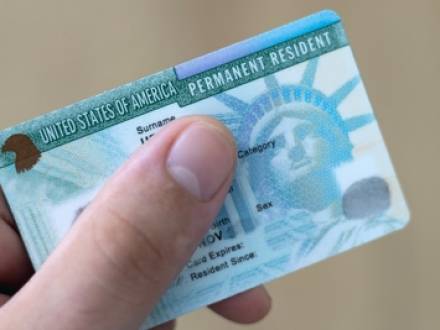Recent Blog Posts
What Illinois Couples Should Know About Fiancé Visas
 For many Illinois couples, the fiancé visa (K-1 visa) is the first significant step toward building a life together in the United States. But bringing your fiancé to live with you in Illinois involves far more than filling out a few immigration forms. The K-1 visa process is highly scrutinized, heavy on documentation, and slower than most people expect. This is particularly true in Chicago-area jurisdictions where Requests for Evidence (RFEs) and longer interview wait times are increasingly common.
For many Illinois couples, the fiancé visa (K-1 visa) is the first significant step toward building a life together in the United States. But bringing your fiancé to live with you in Illinois involves far more than filling out a few immigration forms. The K-1 visa process is highly scrutinized, heavy on documentation, and slower than most people expect. This is particularly true in Chicago-area jurisdictions where Requests for Evidence (RFEs) and longer interview wait times are increasingly common.
Strict timelines, detailed evidence requirements, interviews at U.S. embassies abroad, and Illinois-specific considerations, such as proving a genuine relationship, can make the fiancé visa process stressful and confusing. Understanding what to expect early on can help you know what to expect and keep your visa filing on track. An experienced DuPage County immigration lawyer can help ensure your forms are properly completed, that all required information is provided, and that you are ready for your interview.
Can Police in IL Cite You for Not Carrying Your Green Card?
 Recently, a 60-year-old Chicago man (who is a lawful permanent resident) was issued a $130 ticket following a routine stop. U.S. Immigration and Customs Enforcement (ICE) agents did not detain the man, but when they discovered he was not carrying his green card, they issued a citation. This citation is based on a decades-old – but rarely enforced – provision of federal law that requires all adult non-U.S. citizen to carry their green cards at all times (8 U.S.C. Section 1304(e)).
Recently, a 60-year-old Chicago man (who is a lawful permanent resident) was issued a $130 ticket following a routine stop. U.S. Immigration and Customs Enforcement (ICE) agents did not detain the man, but when they discovered he was not carrying his green card, they issued a citation. This citation is based on a decades-old – but rarely enforced – provision of federal law that requires all adult non-U.S. citizen to carry their green cards at all times (8 U.S.C. Section 1304(e)).
Although the statute describes a $100 maximum fine, DHS has a "modernized" interpretation of the statute as "Noncompliance is a misdemeanor punishable by a fine of up to $5,000 or imprisonment for not more than 30 days, or both." This move by the current administration raises constitutional questions regarding how far the government can go in policing documentation.
2025 Asylum Policy Changes: Impacts, Risks, and Guidance
 The ability to file an asylum claim in the United States has recently undergone changes, with new hurdles being introduced in 2025 through policy updates, executive orders, and new regulations. These updates affect everything from how and where you apply, what must be included in a claim, who is eligible, and how quickly decisions are made.
The ability to file an asylum claim in the United States has recently undergone changes, with new hurdles being introduced in 2025 through policy updates, executive orders, and new regulations. These updates affect everything from how and where you apply, what must be included in a claim, who is eligible, and how quickly decisions are made.
Whether you are already in the process of applying for asylum or planning to do so, it is important to understand these changes. An Itasca, IL immigration lawyer can help you keep up with the changes, ensuring that any application you file is complete and correct.
What Asylum Changes Have Been Made in 2025?
Under Proclamation 10888, the right to seek asylum at the southern border for those apprehended between ports of entry has been suspended. Before the changes, asylum applications were accepted at ports and between ports of entry. There are no exceptions for unaccompanied children or trafficked individuals. The active processing of refugee cases abroad has been indefinitely suspended. Evidentiary demands are now more stringent, demanding proof of persecution or inability to return via the first country, along with more thorough background checks.
What Happens if an Immigrant Sponsor Declares Bankruptcy?
 Immigration has become a much more complicated process over the past few months, with laws changing quickly. Immigrants coming to the United States must, in some situations, have a lawful permanent resident sponsor or a U.S. citizen sign an Affidavit of Support (Form I-864). This document obligates the sponsor to provide financial support to the immigrant when necessary to prevent the immigrant from applying for public assistance.
Immigration has become a much more complicated process over the past few months, with laws changing quickly. Immigrants coming to the United States must, in some situations, have a lawful permanent resident sponsor or a U.S. citizen sign an Affidavit of Support (Form I-864). This document obligates the sponsor to provide financial support to the immigrant when necessary to prevent the immigrant from applying for public assistance.
Unfortunately, in some cases, a sponsor may fall on hard financial times, leading to the difficult decision to file for bankruptcy. Does filing for bankruptcy remove the obligation under federal law to provide for the immigrant financially? While there is additional information below, this is a complex issue that can significantly benefit from the experience and knowledge of an Itasca, IL immigration lawyer.
Could Medical Marijuana Use Impact Your Immigration Status?
 While medical marijuana is legal in the state of Illinois, when it comes to non-citizens, the fallout from using medical marijuana could be significant. Federal law still classifies marijuana as a Schedule I controlled substance, which can, in effect, override state laws, causing immigration consequences.
While medical marijuana is legal in the state of Illinois, when it comes to non-citizens, the fallout from using medical marijuana could be significant. Federal law still classifies marijuana as a Schedule I controlled substance, which can, in effect, override state laws, causing immigration consequences.
This means that using medical marijuana as a non-citizen of the U.S. can jeopardize visa renewals, green card applications, naturalizations, or even result in deportation. If you are facing adverse immigration consequences resulting from medical marijuana use, speak to an experienced Itasca, IL immigration attorney as soon as possible.
Federal vs. State Law on Medical Marijuana
There are currently 40 states, including Illinois, that have legalized the use of medical marijuana. Twenty-four states have legalized recreational marijuana. Although the federal government has largely stayed out of these decisions, federal law supersedes state law.
Immigration Hearings: Caught Between Justice and Deportation
 With immigration laws in limbo, many undocumented immigrants face fear and uncertainty over the once-simple act of attending a scheduled court hearing. There are increasing reports of Immigration and Customs Enforcement (ICE) agents arresting undocumented immigrants at courthouses as they attend required court hearings.
With immigration laws in limbo, many undocumented immigrants face fear and uncertainty over the once-simple act of attending a scheduled court hearing. There are increasing reports of Immigration and Customs Enforcement (ICE) agents arresting undocumented immigrants at courthouses as they attend required court hearings.
This leaves immigrants seeking legal status or asylum in the United States with a serious dilemma: comply with a court-ordered appearance and risk detention, or avoid court and face serious legal consequences. Deciding between two bad choices can seem like no choice at all. Consulting with an experienced Itasca, IL immigration lawyer can help you determine the necessary steps to protect your immigration status and avoid deportation.
The Legal Obligation to Appear in Court
Attending immigration court appearances is generally considered mandatory. Missing one of these court dates can have devastating consequences. A judge will almost certainly issue an in absentia removal order if you fail to show up, which is a deportation order made in your absence. Missing a court date could also result in the loss of eligibility for asylum or other forms of relief, as well as an inability to re-enter the U.S., either temporarily or permanently.
What is a Nonimmigrant Visa, and Who Needs One?
 While nonimmigrant visas may be less common than immigrant visas, in 2023, the U.S. Department of State issued 10,438,327 nonimmigrant visas. Immigrant visas are provided to those who want to live and work in the United States on a permanent basis. A nonimmigrant visa is issued to a person who has a permanent residence outside the United States but wants to temporarily come into the U.S. for a specific reason.
While nonimmigrant visas may be less common than immigrant visas, in 2023, the U.S. Department of State issued 10,438,327 nonimmigrant visas. Immigrant visas are provided to those who want to live and work in the United States on a permanent basis. A nonimmigrant visa is issued to a person who has a permanent residence outside the United States but wants to temporarily come into the U.S. for a specific reason.
The reasons for obtaining a nonimmigrant visa may include study, work, business, tourism, or medical treatment. There are more than 20 different categories for nonimmigrant visa classifications. If you have questions regarding nonimmigrant or immigrant visas, speaking to a knowledgeable Itasca, IL immigration attorney can be beneficial.
Is Traveling Currently Risky During the Immigration Crackdown?
 A U.S. citizen who landed at an airport near Seattle in February waited, along with her aunt, in the same line to go through customs. While the one woman went through customs quickly, as she waited for her aunt the minutes soon turned into hours. Many hours later, the woman found that her aunt had been detained by U.S. Customs and Border Protection (CBP).
A U.S. citizen who landed at an airport near Seattle in February waited, along with her aunt, in the same line to go through customs. While the one woman went through customs quickly, as she waited for her aunt the minutes soon turned into hours. Many hours later, the woman found that her aunt had been detained by U.S. Customs and Border Protection (CBP).
The aunt is a lawful permanent resident who has lived in the U.S. for more than 50 years, ever since she and her family immigrated to the U.S. from the Philippines. Over the years, she has traveled between countries with her green card, never having any problems whatsoever.
After the family of the woman who was detained hired a lawyer, they finally found out that her detainment was due to a criminal conviction that was over 20 years old – and for which she completed all court requirements. She was transferred by ICE to a Tacoma processing center, where she will remain until her hearing date in July. Unfortunately, any past infraction – no matter how small - can turn into a major issue for immigrants, especially at border crossings and airports.
Illinois Venezuelans Could Soon Lose Deportation Protections
 In the coming weeks, tens of thousands of Venezuelans living and working in Illinois could find themselves at risk of deportation. The current administration has said it will halt the 2023 Temporary Protected Status (TPS) for Venezuela on April 7th. Without temporary protected status, many of these individuals will be left without legal status, resulting in the loss of work permits and any financial assistance they are currently receiving.
In the coming weeks, tens of thousands of Venezuelans living and working in Illinois could find themselves at risk of deportation. The current administration has said it will halt the 2023 Temporary Protected Status (TPS) for Venezuela on April 7th. Without temporary protected status, many of these individuals will be left without legal status, resulting in the loss of work permits and any financial assistance they are currently receiving.
Immigration as a whole is currently in a state of flux, making it difficult for those who are here lawfully or unlawfully to know what is best. If you or a loved one came to the U.S. under the 2023 TPS designation, you may be extremely anxious about your future. It can be very helpful to speak to a knowledgeable Itasca, IL immigration lawyer.
Laken Riley Act Would Detain Migrants Charged with Shoplifting
 The first bill signed by the new administration was the Laken Riley Act, named after a slain Georgia nursing student. The Act requires the detention of unauthorized immigrants who have been accused of theft or of a violent crime. Laken Riley was reportedly out for a run when she encountered a man who killed her during a struggle.
The first bill signed by the new administration was the Laken Riley Act, named after a slain Georgia nursing student. The Act requires the detention of unauthorized immigrants who have been accused of theft or of a violent crime. Laken Riley was reportedly out for a run when she encountered a man who killed her during a struggle.
The man was later found guilty of murder by a judge and sentenced to life without parole. Because the man was arrested in 2022 for illegal entry into the United States, many believed he would not have had the opportunity to kill the nursing student if the current bill had been in place. The pros and cons of the bill are detailed below; however, if you have any questions about this bill or other immigration issues, speak to an Itasca, IL, immigration attorney.
What Does the Laken Riley Act Do?
The Laken Riley Act gives state attorneys general the ability to sue the federal government for any harm caused by immigration enforcement decisions that harm the state or its residents. This could include failing to detain an undocumented immigrant who has received deportation orders or releasing an undocumented immigrant from custody.



Contact Unzueta Law Group, P.C.
The use of the Internet or this form for communication with the firm or any individual member of the firm does not establish an attorney-client relationship. Confidential or time-sensitive information should not be sent through this form.
I have read and understand the Disclaimer and Privacy Policy.



